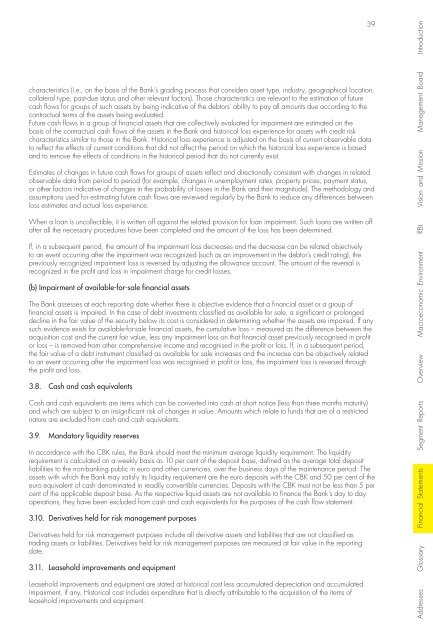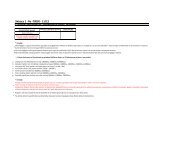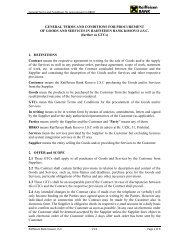Annual Report 2012 - Raiffeisen Bank Kosovo JSC
Annual Report 2012 - Raiffeisen Bank Kosovo JSC
Annual Report 2012 - Raiffeisen Bank Kosovo JSC
Create successful ePaper yourself
Turn your PDF publications into a flip-book with our unique Google optimized e-Paper software.
characteristics (i.e., on the basis of the <strong>Bank</strong>’s grading process that considers asset type, industry, geographical location,<br />
collateral type, past-due status and other relevant factors). Those characteristics are relevant to the estimation of future<br />
cash flows for groups of such assets by being indicative of the debtors’ ability to pay all amounts due according to the<br />
contractual terms of the assets being evaluated.<br />
Future cash flows in a group of financial assets that are collectively evaluated for impairment are estimated on the<br />
basis of the contractual cash flows of the assets in the <strong>Bank</strong> and historical loss experience for assets with credit risk<br />
characteristics similar to those in the <strong>Bank</strong>. Historical loss experience is adjusted on the basis of current observable data<br />
to reflect the effects of current conditions that did not affect the period on which the historical loss experience is based<br />
and to remove the effects of conditions in the historical period that do not currently exist.<br />
Estimates of changes in future cash flows for groups of assets reflect and directionally consistent with changes in related<br />
observable data from period to period (for example, changes in unemployment rates, property prices, payment status,<br />
or other factors indicative of changes in the probability of losses in the <strong>Bank</strong> and their magnitude). The methodology and<br />
assumptions used for estimating future cash flows are reviewed regularly by the <strong>Bank</strong> to reduce any differences between<br />
loss estimates and actual loss experience.<br />
When a loan is uncollectible, it is written off against the related provision for loan impairment. Such loans are written off<br />
after all the necessary procedures have been completed and the amount of the loss has been determined.<br />
If, in a subsequent period, the amount of the impairment loss decreases and the decrease can be related objectively<br />
to an event occurring after the impairment was recognized (such as an improvement in the debtor’s credit rating), the<br />
previously recognized impairment loss is reversed by adjusting the allowance account. The amount of the reversal is<br />
recognized in the profit and loss in impairment charge for credit losses.<br />
(b) Impairment of available-for-sale financial assets<br />
The <strong>Bank</strong> assesses at each reporting date whether there is objective evidence that a financial asset or a group of<br />
financial assets is impaired. In the case of debt investments classified as available for sale, a significant or prolonged<br />
decline in the fair value of the security below its cost is considered in determining whether the assets are impaired. If any<br />
such evidence exists for available-for-sale financial assets, the cumulative loss – measured as the difference between the<br />
acquisition cost and the current fair value, less any impairment loss on that financial asset previously recognised in profit<br />
or loss – is removed from other comprehensive income and recognised in the profit or loss. If, in a subsequent period,<br />
the fair value of a debt instrument classified as available for sale increases and the increase can be objectively related<br />
to an event occurring after the impairment loss was recognised in profit or loss, the impairment loss is reversed through<br />
the profit and loss.<br />
3.8. Cash and cash equivalents<br />
Cash and cash equivalents are items which can be converted into cash at short notice (less than three months maturity)<br />
and which are subject to an insignificant risk of changes in value. Amounts which relate to funds that are of a restricted<br />
nature are excluded from cash and cash equivalents.<br />
3.9. Mandatory liquidity reserves<br />
In accordance with the CBK rules, the <strong>Bank</strong> should meet the minimum average liquidity requirement. The liquidity<br />
requirement is calculated on a weekly basis as 10 per cent of the deposit base, defined as the average total deposit<br />
liabilities to the non-banking public in euro and other currencies, over the business days of the maintenance period. The<br />
assets with which the <strong>Bank</strong> may satisfy its liquidity requirement are the euro deposits with the CBK and 50 per cent of the<br />
euro equivalent of cash denominated in readily convertible currencies. Deposits with the CBK must not be less than 5 per<br />
cent of the applicable deposit base. As the respective liquid assets are not available to finance the <strong>Bank</strong>’s day to day<br />
operations, they have been excluded from cash and cash equivalents for the purposes of the cash flow statement.<br />
3.10. Derivatives held for risk management purposes<br />
Derivatives held for risk management purposes include all derivative assets and liabilities that are not classified as<br />
trading assets or liabilities. Derivatives held for risk management purposes are measured at fair value in the reporting<br />
date.<br />
3.11. Leasehold improvements and equipment<br />
Leasehold improvements and equipment are stated at historical cost less accumulated depreciation and accumulated<br />
impairment, if any. Historical cost includes expenditure that is directly attributable to the acquisition of the items of<br />
leasehold improvements and equipment.<br />
39<br />
Addresses Glossary Financial Statements Segment <strong>Report</strong>s Overview Macroeconomic Environment RBI Vision and Mission Management Board Introduction

















